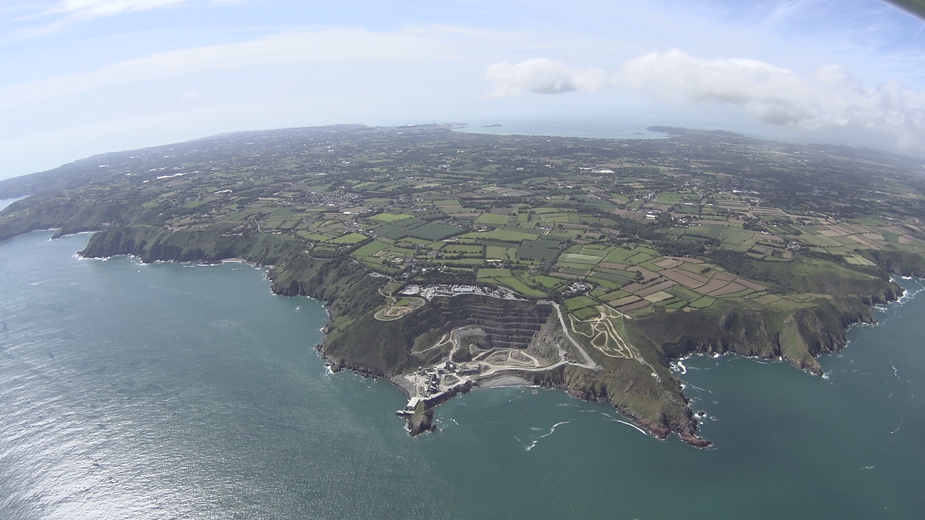With the action cams which I was referring to, the distortion is definitely from the lens. The Sony sensors in these “few hundred €” cameras are very good.
The cause is the very wide angle of view from the commonly marketed lenses e.g. 170 degrees. That is the “action cam market” i.e. most people who buy the Go-Pro type of product like that sort of fish-eye look. It also gives you great depth of focus (these cameras don’t focus) and the wide angle makes camera shake a lot less of a problem. Go-Pro made a huge amount of money out of this market (their bubble seems to have burst recently though) but other makes followed them with various different packagings of the same Sony sensors and the same crappy software and crappy user interfaces…
These cameras are no good for making decent movies, especially (IMHO) decent flying movies which anybody wants to watch more than once. You have to either fit a different lens (I am told there are specialists in the USA who sell various lenses for the Go-Pro) or digitally zoom them to use a smaller part of the sensor (which reduces the angle of view and reduces the distortion) or software-correct the distortion.
Hence this old thread
One problem with lens correction is that the distortion is nonlinear so a generic lens correction plug-in doesn’t do a geometrically perfect job. With the Sony X1000 the corners would always show strange effects. With the X3000 it is a lot better because the lens is better to start with, but also this camera has usable modes where the angle of view is smaller – say 120 degrees.
Anyway, back on the topic, I will try to do some flying tests to see which produces a better result. Flying videos done a few thousand feet (or more) above the terrain produce a slowly moving scene which apart from the motion vector is largely constant and which should work well with mpeg compression. However, this isn’t so when the aircraft is turning and then much more bandwidth is needed.
I can’t shoot at 4K 100mbps because then the 256GB SD card lasts less than some long flights I do, which would require remote on/off of the camera and resulting issues with sound and GPS position subtitle sync – some stuff here.
This is an uncorrected Sony X1000

Here are a few videos.
Vimeo downgrades everything to about 5mbps which makes comparisons difficult but all of these can be downloaded using the Download button there and then you get the original size. Had I put them on dropbox, the account would get shut due to the volume of downloads and I don’t have webspace on which I can put the 4.9GB which these add up to in their original upload form.
All were rendered to 1080P in Vegas 14.
The 4K 100mbps is the most common camera mode I propose to use. It is the X3000’s top mode. It will run for 5.5hrs which is not enough in some applications and then I will use the 60mbps setting which appears to be just as good (so I might use it all the time).
4K 30fps 100mbps:
The following interpolated video shows the interpolation clearly if you freeze a frame (pressing the space bar in VLC, etc) and then any man-made “sharp” objects have a shadow which has a 50% opacity. In normal playback I don’t see this video is smoother than any of the others, and 30fps appears perfectly sufficient for this kind of footage
4K 30fps 100mbps interpolated to 60fps:
The following was shot in 1080P 60fps 50mbps:
The following two are ground based and show very similar scenery. I find it impossible to see any difference between them and thus conclude that 60mbps is perfectly fine for 4k recording in this case. However I don’t have a 4K monitor and the only way I can see 4K scenery is by doing a snapshot in VLC, and even then I can’t see any difference!
4K 30fps 100mbps:
4K 30fps 60mbps:
The later of the above videos also have a bit of lens correction (with a tiny bit of crop – about 5%) which shows up as a more straight horizon.
Some also have the exposure reduced by -0.7 which helps to prevent bright clouds getting washed out; these look darker as a result. I am not sure how to best deal with this in Vegas because I don’t want to introduce saturation there either. Maybe I can use a tone curve function (the equivalent of brighten up shadows in photoshop, etc).
In case anybody is interested, the X3000 camera has certain issues when externally powered – I posted it here
The internal battery lasts about 1 hour when recording in 4K 100mbps; wifi and bluetooth don’t seem to affect it much.
The bottom line? I can’t see any difference between 4K 100mbps 30fps and 4K 60mbps 30fps. Even 1080P 50mbps 60fps looks the same, except when the runway tarmac is very close and then the need for bandwidth shows up.
This 4K video shows that 30fps is OK for flying videos, although IMHO only just about: